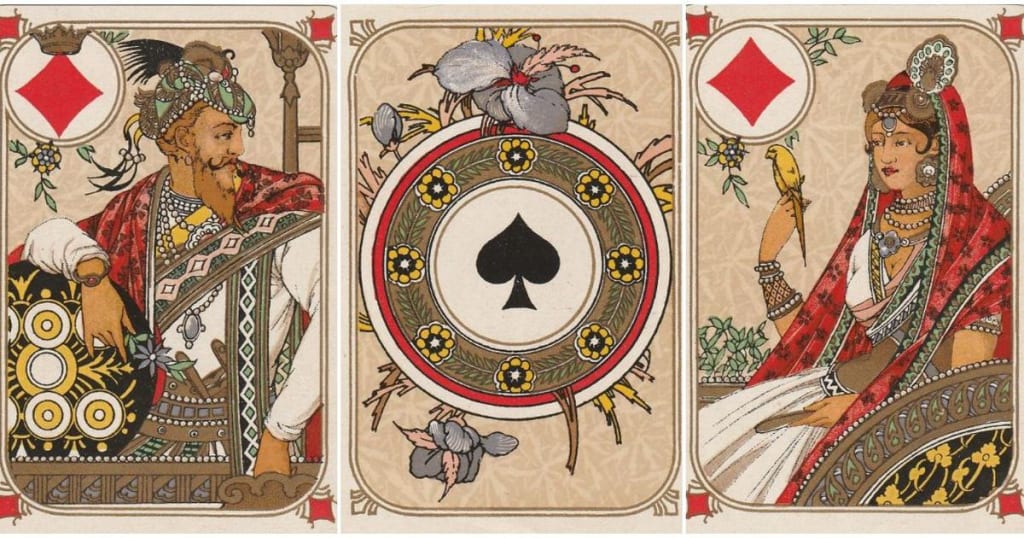How Mughal badshahs and begums became a source of inspiration for 19th-century French playing cards
Although un-subcontintental in colour tones, the Cartes Indiennes recall the nobles and attendants of South Asian painting, most famously Mughal miniatures.

Someone suggests a game of cards or – if you move in astrologically-inclined circles – offers to read fortunes.
The host produces a deck.
As they slide the cards out of the box, you expect to see the familiar visages of king, queen and jack – primary-coloured, angular icons denoting mediaeval European nobility.
Instead, you find yourself looking at a completely different court – men in jamas, women in cholis, adorned with jewellery and accessorised with parakeets and pakhawajs. Yet the colour tones are rather un-subcontintental, and the features rendered in the simplified lines of early graphic design.
Turns out, you’re looking at a rare set of vintage playing cards: a series called Cartes Indiennes issued towards the end of the 19th century by one of the biggest European playing card manufacturers of the time. In her book A History of Playing Cards and a Bibliography of Cards and Gaming, Catherine Perry Hargrave describes this striking series as having “real artistic merit…most beautiful and unusual designing, lithographing and color”.
In dress, pose and iconography, the Cartes Indiennes’ courtiers recall the nobles and attendants of South Asian painting, most famously the Mughal miniatures. But the pastel colour palette, flatness and sleek figuration are modern, befitting their appearance on mass-produced print objects, the style belonging to late 19th-century Europe. The very title of the cards – Indiennes – alludes to printed textiles made in Europe based on Indian patterns. Precisely what makes these playing cards art historically interesting is their combination of Indian imagery with the visual language dominating fin de siécle Western art, resulting in a unique Art Nouveau darbar.
Visual cues
Little information has survived about these cards, such as who designed them or what the contemporary response to them was. Entries on the two complete decks in the collection of the Bibliothéque Nationale de France furnish scant details, namely the name of the manufacturer (B.P. Grimaud), the period of production (between 1890 and 1900), the process of production (chromolithography), the size (9.3 x 6.3 cm), and notes on the physical characteristics (“rounded corners and orange and gold spine” in one case and “square corners and green and gold spine” in the other). The artistic language of the cards is described in the entries as “Tarot back in Art Nouveau style with carnation pattern”. As for ownership, one of the decks belonged to Henri-Rene d’Allegmane, an archivist and historian of the decorative arts and author of Antique Playing Cards: A Pictorial History.
Given their relative scarcity, these cards command high prices on auction sites and generate much discussion in hobbyist communities, occasionally with illuminating results. Though the Bibliothéque entries only list the peach orange and mint green editions, on a message board called United Cardists, a collector with the username ‘acetofive’ recorded six different variations of the Cartes Indiennes deck that they had compiled at the time of posting in June 2020.
The compositions of the cards and the attire of the badshahs, begums and ghulams reference different periods and perhaps even regions. For instance, the framing of the figures includes profiles, three-quarter profiles and frontal depictions. The kings resemble portraits of Mughal emperors from different generations, and the queens seem to be modelled on images of women from the Mughal atelier as well as later representations from provincial schools.
Why did India become a source of inspiration for the design of popular French playing cards? And what does this choice of theme tell us about the age in which they were made?
Source of inspiration
Incidentally, the Mughals had an important influence in the history of playing cards, as well as that of their design. As the art critic Rudolf van Leyden speculated in his 1982 survey Ganjifa: Playing Cards of India, it was probably Babar who, in the 16th century, brought the Persian card game of ganjifa from Central Asia to India. However, in the story of Western playing cards, the Mughals played a more passive role, as branding symbols. According to Adam Wintle in his article The Great Mogul Playing Cards on the comprehensive World of Playing Cards website, in the 18th century, a major British card-maker called Christopher Blanchard registered a trademark called the Great Mogul. This became the focus of an intellectual property dispute that ended up weakening Blanchard’s exclusive claim on the design. Like their flesh and blood namesakes, the playing card Great Moguls turned out to be profitable business for foreign companies. Wintle makes the point that in the modern age, “Mogul playing cards were produced by various companies in different countries…in various qualities such as Court Moguls, Moguls, Oriental Moguls, Double Moguls, Floral Moguls and Great Moguls…”
About the Creator
Enjoyed the story? Support the Creator.
Subscribe for free to receive all their stories in your feed. You could also pledge your support or give them a one-off tip, letting them know you appreciate their work.






Comments
There are no comments for this story
Be the first to respond and start the conversation.